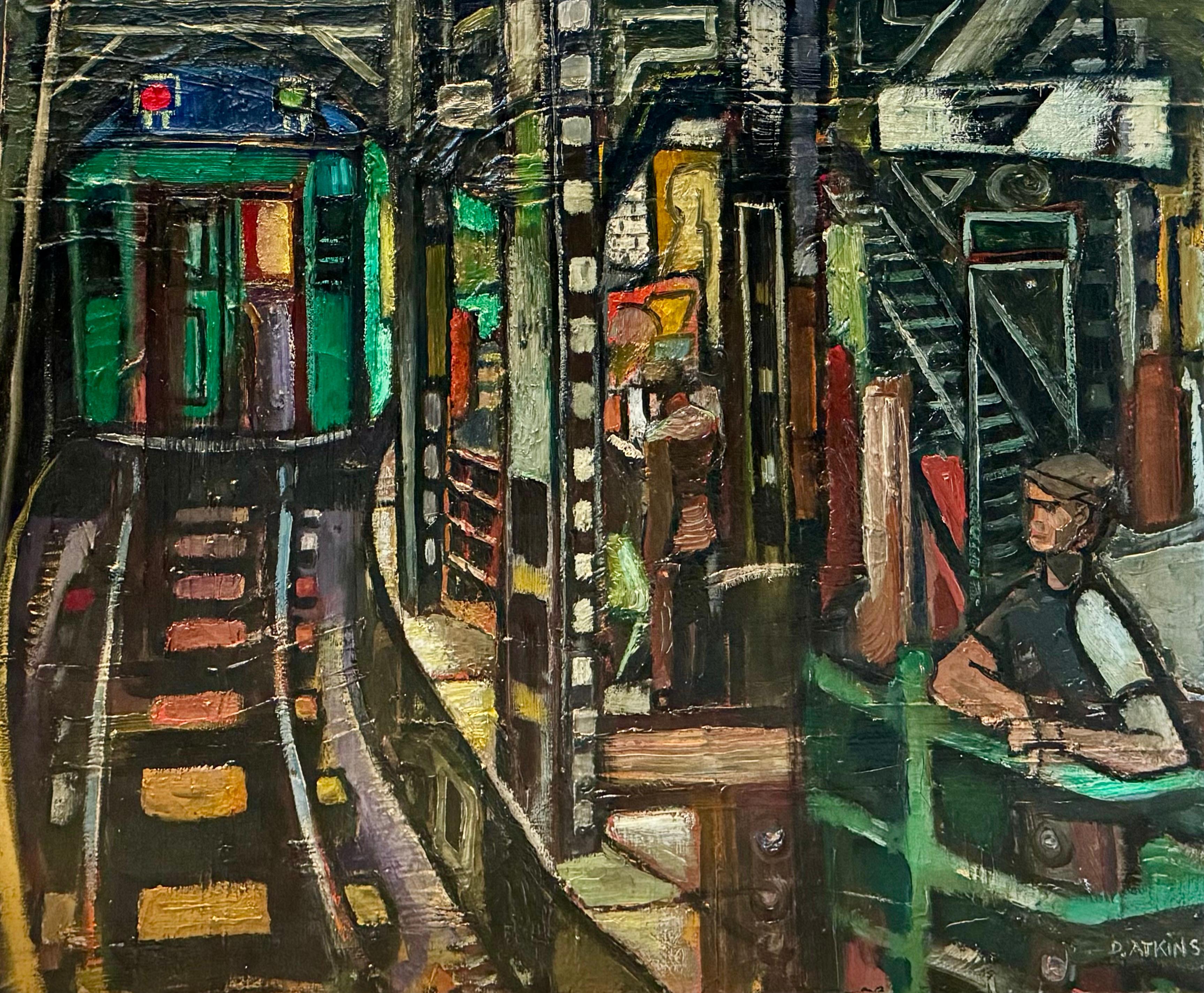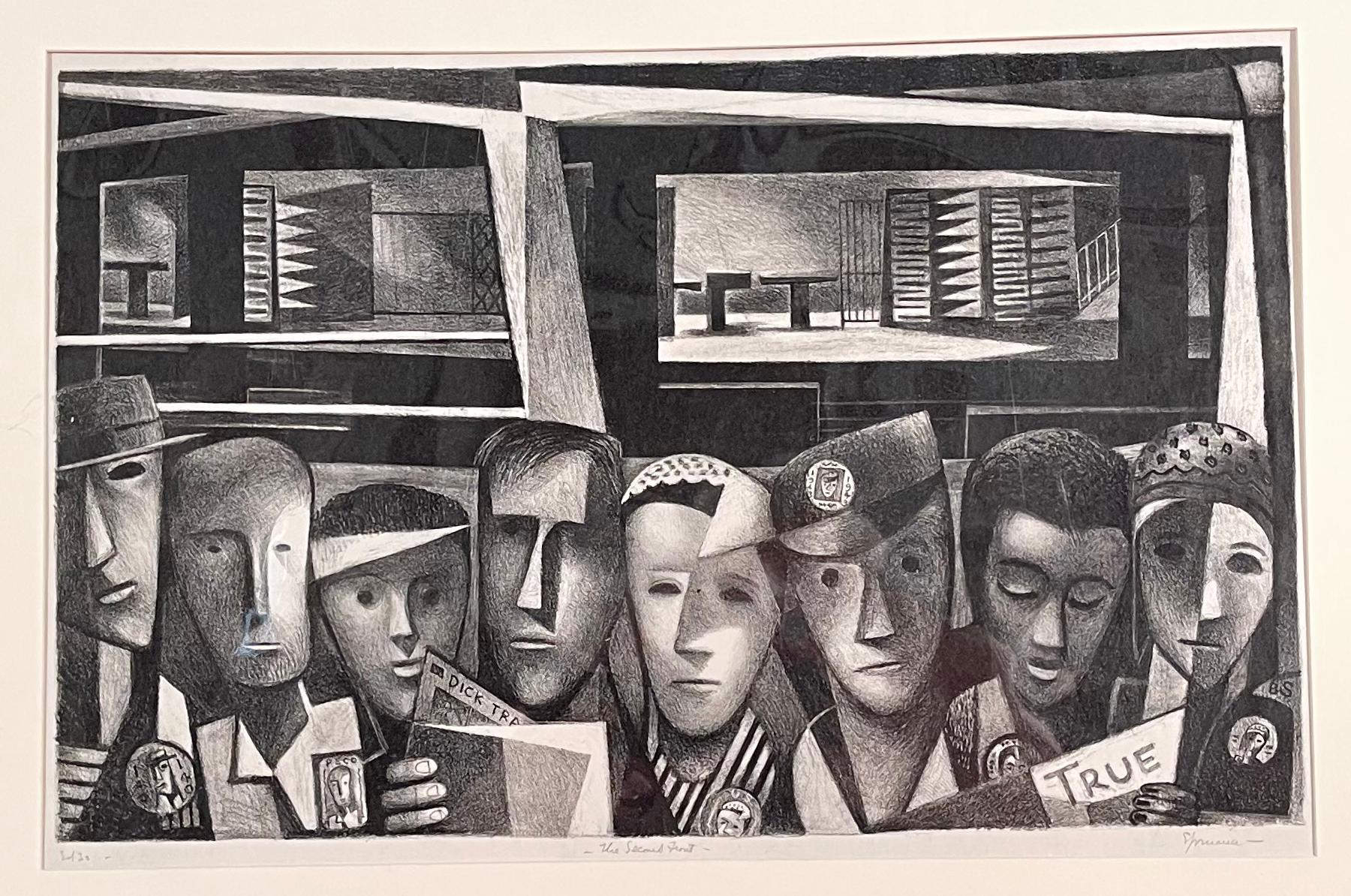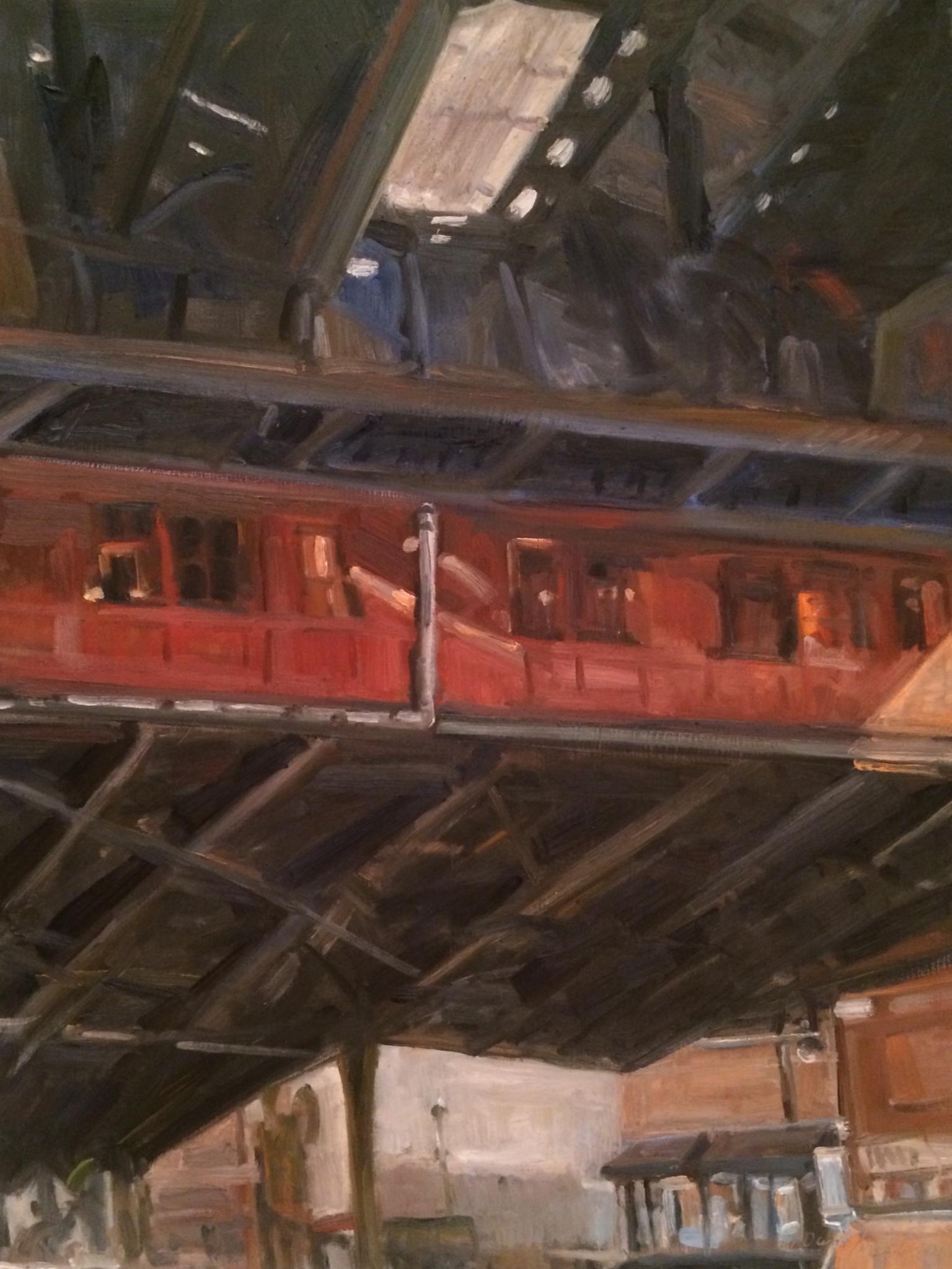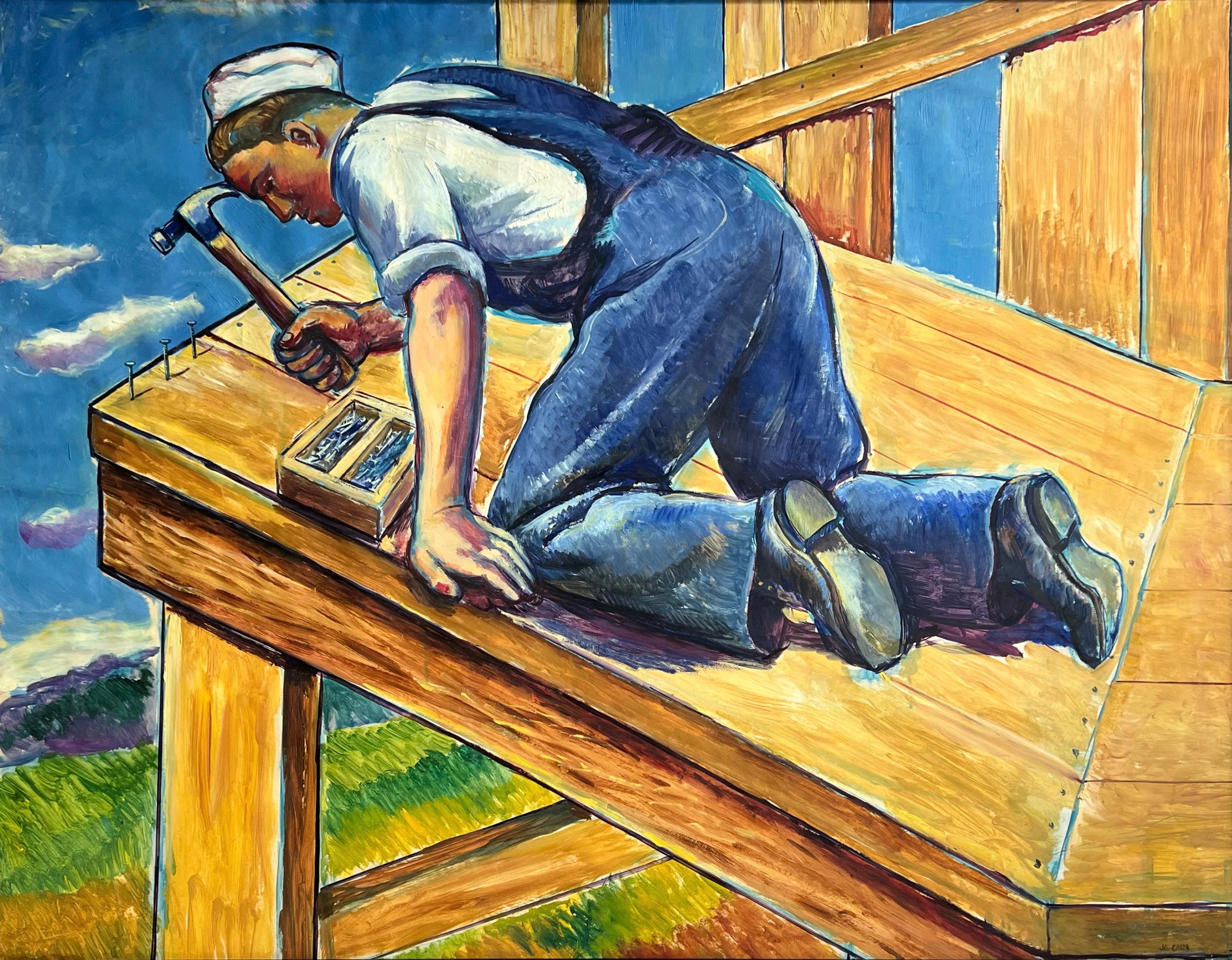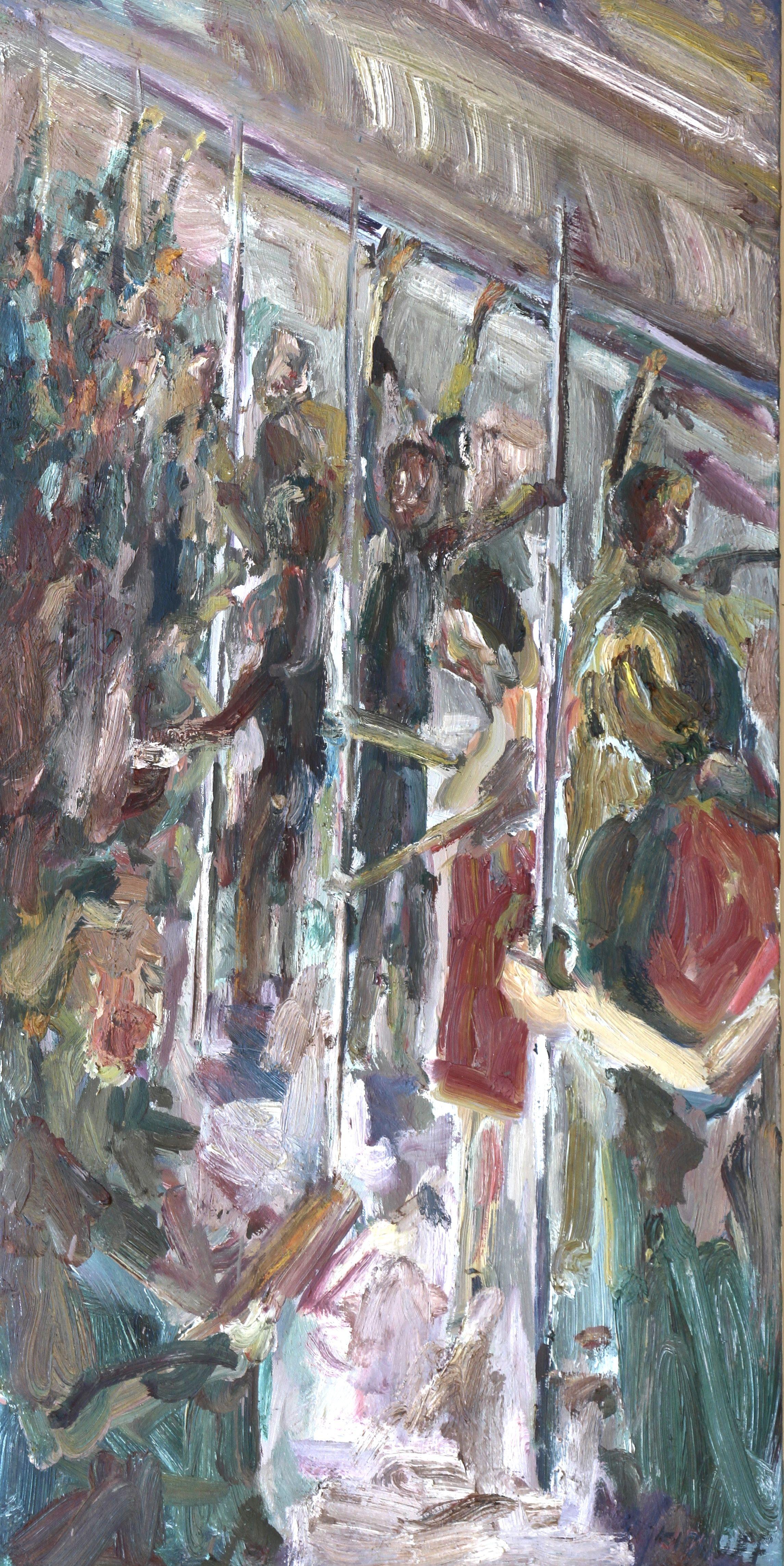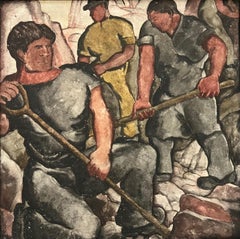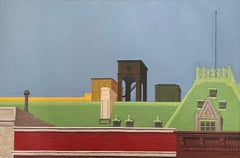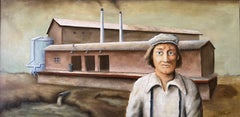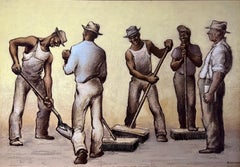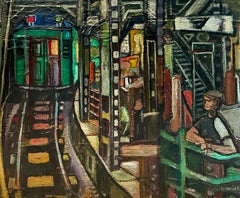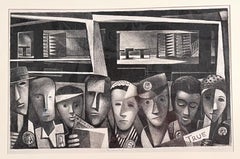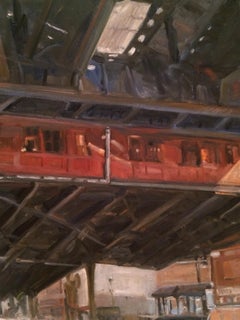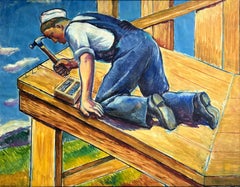Items Similar to Subway Construction
Want more images or videos?
Request additional images or videos from the seller
1 of 6
Ernest StockSubway Construction
$7,500
£5,734.63
€6,569.06
CA$10,578.04
A$11,512.96
CHF 6,152.11
MX$139,032.63
NOK 77,317.02
SEK 71,913.83
DKK 49,073.99
About the Item
This painting is part of our exhibition American Coast to Coast: Artists of the 1930s
Subway Construction, c. 1928, oil on board, 19 x 15 ¾ inches, signed upper left, artist and title verso; exhibited: 1) 12th Annual Exhibition of the Society of Independent Artists, The Waldorf Astoria, New York NY, from March 9 to April 1, 1928, no. 864 (original price $250) (see Death Prevailing Theme of Artists in Weird Exhibits, The Gazette (Montreal, Quebec, Canada), March 8, 1928); 2) Boston Tercentenary Exhibition Fine Arts and Crafts Exhibition, Horticultural Hall, Boston MA, July, 1930, no. 108 (honorable mention - noted verso); 3) 38th Annual Exhibition of American Art, Cincinnati Art Museum, Cincinnati, OH, June, 1931 (see Alexander, Mary, The Week in Art Circles, The Cincinnati Enquirer, June 7, 1931); and 4) National Art Week Exhibition [Group Show], Montross Gallery, New York, New York, December, 1940 (see Devree, Howard, Brief Comment on Some Recently Opened Exhibitions in the Galleries, The New York Times, December 1, 1940)
About the Painting
Ernest Stock’s Subway Construction depicts the excavation of New York’s 8th Avenue line, which was the first completed section of the city-operated Independent Subway System (IND). The groundbreaking ceremony was in 1925, but the line did not open until 1932, placing Stock’s painting in the middle of the construction effort. The 8th Avenue line was primarily constructed using the “cut and cover” method in which the streets above the line were dug up, infrastructure was built from the surface level down, the resulting holes were filled, and the streets reconstructed. While many artists of the 1920s were fascinated with the upward thrust of New York’s exploding skyline as architects and developers sought to erect ever higher buildings, Stock turned his attention to the engineering marvels which were taking place below ground. In Subway Construction, Stock depicts workers removing the earth beneath the street and building scaffolding and other support structures to allow concrete to be poured. Light and shadow fall across the x-shaped grid pattern formed by the wooden beams and planks. It is no surprise that critics reviewing the painting commented on Stock’s use of an “interesting pattern” to form a painting that is “clever and well designed.”
About the Artist
Ernest Richard Stock was an award-winning painter, print maker, muralist, and commercial artist. He was born in Bristol, England and was educated at the prestigious Bristol Grammar School. During World War I, Stock joined the British Royal Air Flying Corps in Canada and served in France as a pilot where he was wounded. After the war, he immigrated to the United States and joined the firm of Mack, Jenny, and Tyler, where he further honed his architectural and decorative painting skills. During the 1920s, Stock often traveled back and forth between the US and Europe. He was twice married, including to the American author, Katherine Anne Porter. Starting in the mid-1920s, Stock began to exhibit his artwork professionally, including at London’s Beaux Arts Gallery, the Society of Independent Artists, the Salons of America, the Cincinnati Art Museum, the Whitney Studio and various locations in the Northeast. Critics often praised the strong design sensibility in Stock’s paintings. Stock was a commercial illustrator for a handful of published books and during World War II, he worked in the Stratford Connecticut design department of United Aircraft’s Sikorsky Aviation Division focusing on helicopters. Stock is listed in Who Was Who in American Art and other standard references.
- Creator:Ernest Stock (1896 - 1955, American)
- Dimensions:Height: 19 in (48.26 cm)Width: 15.5 in (39.37 cm)Depth: 2 in (5.08 cm)
- More Editions & Sizes:19 x 15.5Price: $7,500
- Medium:
- Movement & Style:
- Period:
- Condition:
- Gallery Location:Los Angeles, CA
- Reference Number:1stDibs: LU1859213056312
About the Seller
5.0
Gold Seller
Premium sellers maintaining a 4.3+ rating and 24-hour response times
1stDibs seller since 2022
17 sales on 1stDibs
- ShippingRetrieving quote...Shipping from: Los Angeles, CA
- Return Policy
More From This Seller
View AllQuarry Workers
Located in Los Angeles, CA
This painting is part of our exhibition America Coast to Coast: Artists of the 1930s
Quarry Workers, c. 1930s, mixed media on board, unsigned, 24 x 24 inches, possibly exhibited at...
Category
1930s American Modern Figurative Paintings
Materials
Mixed Media
The Railway Station
Located in Los Angeles, CA
The Railway Station, c. 1934, oil on canvas, signed lower right, titled verso and noted "34"; illustrated Kaufman, Jeffrey, Brush with Life: The Art of Being Edward Biberman...
Category
1930s American Modern Landscape Paintings
Materials
Oil
Factory Worker
Located in Los Angeles, CA
This painting is part of our exhibition America Coast to Coast: Artists of the 1930s
Factory Worker, c. 1936, oil on canvas, signed lower right, 18 ¼ x 36 inches; exhibited in City ...
Category
1930s American Realist Figurative Paintings
Materials
Oil
Street Cleaners
Located in Los Angeles, CA
This painting is part of our exhibition America Coast to Coast: Artists of the 1930s
Street Cleaners, c. 1940s, oil on canvas, signed lower right, 28 ¾ x 42 inches, Gallery Z...
Category
1940s American Modern Figurative Paintings
Materials
Oil
Untitled (Elevated Platform)
Located in Los Angeles, CA
This painting is part of our current exhibition - America Coast to Coast: Artists of the 1940s
Untitled (Elevated Platform), 1950, oil on canvas, signed and dated lower right, 30 x...
Category
1950s American Modern Paintings
Materials
Canvas, Oil
Moonlight Shanties
Located in Los Angeles, CA
Moonlight Shanties, c. 1940s, oil on canvas, 24 x 18 inches, signed lower right, signed and titled verso
About the Painting
In Moonlight Shanties, Joachim depicts a lower-class neighborhood sitting along-side an elevated road or railway which crowds out the small nearby houses and structures. Joachim’s use of an expressionist palette and gestural brushstrokes together with the isolated figures obscured in the shadows, create a feeling of unease, isolation and even loneliness. From the 1920s through 1940s, American artists commonly employed expressionist conventions in their social realist works which portrayed the gritty side of urban America, especially the communities of the city-dwelling poor. Expressionist styles were considered appropriate for bridging the gap between the modernist idea of art-for-art’s-sake and the narrative qualities demanded by the dual crises of the Great Depression and World War II. Moonlight Shanties successfully uses these expressionist methods to portray a neighborhood and its people who appear to be literally and figuratively “on the edge.”
About the Artist
Paul Lamar Joachim...
Category
1940s American Modern Landscape Paintings
Materials
Oil
You May Also Like
NYC Subway Mid 20th Century Modern American Scene Social Realism Contemporary
Located in New York, NY
NYC Subway Mid 20th Century Modern American Scene Social Realism Contemporary
David Atkins (1910 – 2012)
Subway Train Departure
24 x 30 inches
Oil on can...
Category
1960s American Modern Interior Paintings
Materials
Canvas, Oil
SUBWAY SHIFT - THE SECOND FRONT
By Benton Murdoch Spruance
Located in Portland, ME
Spruance, Benton (American 1904-1967). SUBWAY SHIFT - THE SECOND FRONT. Fine and Looney 223. Lithograph, 1943. Fine and Looney cite two editions, one of 35 and one of 30, this being ...
Category
1940s Figurative Prints
Materials
Lithograph
Elevated Subway Station, Painting, Oil on MDF Panel
By Howard Danelowitz
Located in Yardley, PA
Interesting Perspective of Queens New York elevated subway station. :: Painting :: Contemporary :: This piece comes with an official certificate of au...
Category
2010s Contemporary Paintings
Materials
Oil
Industrial Man Working Mid 20th Century American Scene Social Realism Modern WPA
By Jo Cain
Located in New York, NY
Industrial Man Working Mid 20th Century American Scene Social Realism Modern WPA
Jo Cain (1904 - 2003)
Hammering Nails
39 x 50 ½ inches
Gouache on paper c. 19...
Category
1930s American Realist Figurative Drawings and Watercolors
Materials
Paper, Gouache
NYC Subway #3, Painting, Oil on Canvas
By John Kilduff
Located in Yardley, PA
I did a number of sketches while riding the subways in New York this summer (2016). This painting is based on one of these sketches. :: Painting :: Impressionist :: This piece come...
Category
2010s Impressionist Paintings
Materials
Oil
Charles Keller Original Stone Lithograph - "6th Avenue Subway”
Located in Phoenix, AZ
Original lithograph by Charles Keller depicting the subway being built in New York
on 6th Avenue in 1937. This print is inscribed lower left: “To W.B.”
The print is in excellent con...
Category
Mid-20th Century More Prints
Materials
Lithograph
More Ways To Browse
Antique Montreal
Royal Flying Corps
Cafe Scene Painting
Charlie Chaplin Vintage
Blue Face Painting
Isaac Pelayo
Kibbutz Art
New Yorker Cover
Opera Singer
Picasso Oil Painting
Shaw London
Vintage Circus Performers
Dior 1955
Golden Age Of Illustration
Jazz Oil Painting
Old Master Christ
Shadow Puppets
Social Realism Social Realism Art 1930s And 1940s
